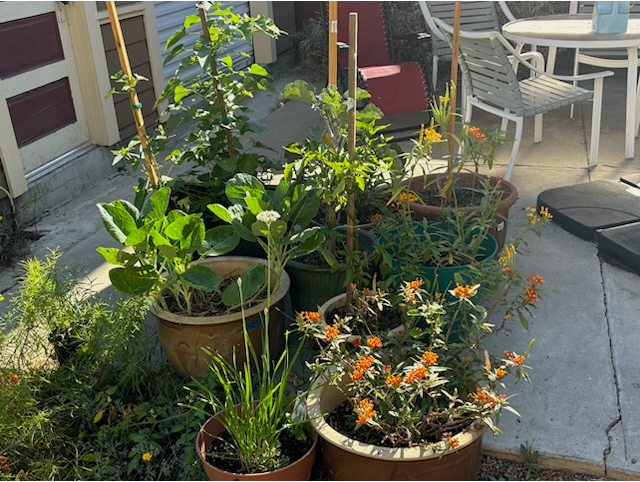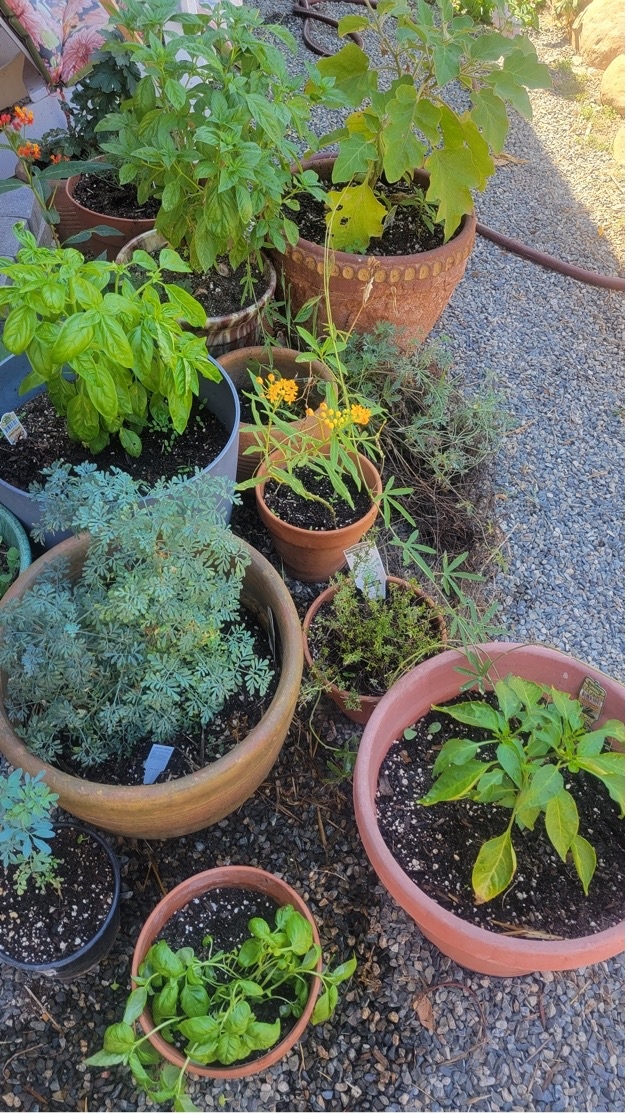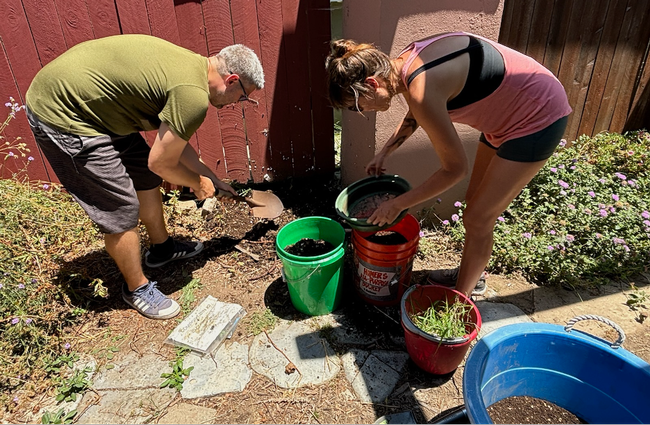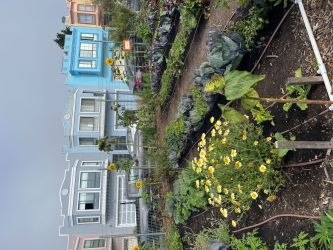- Author: Allison Bunyan, FSA Urban County Program Analyst

As the FSA evolves to address the changing needs of our farmers and ranchers, the agency has taken strides to better serve urban producers. As of today, 17 Urban Service Centers have opened in major metropolitan centers across the US, with an additional 10 offices being planned. In California, we have two new Urban Service Centers.
- Oakland Urban Service Center Contacts:
- NRCS: Annie Edwards, Urban Conservationist, annie.edwards@usda.gov
- FSA: Thomas Schultz, Urban County Executive Director, thomas.schultz2@usda.gov
- FSA: Allison Bunyan, Urban County Program Analyst, allison.bunyan@usda.gov
- Compton Urban Service Center Contacts:
- NRCS: Jamie Quarfeld, Urban Conservationist, jamie.quarfeld@usda.gov
- FSA: Evelin Carias, Acting County Executive Director, evelin.carias@usda.gov
The FSA has a variety of programs and services to assist you with registering your farm with the USDA, financing your urban farm or garden, managing risk, and reimbursing organic and food safety certification expenses.
Financing Your Urban Farm or Garden
FSA loan programs provide access to capital, either directly from FSA or through a third-party, commercial lender. You may be interested in using the Farm Loan Assistance Tool to determine which loan option works best for you.
Managing Risk

- Risk management coverage options through the Noninsured Crop Disaster Assistance Program (NAP) that covers crops that are not insurable through USDA's federal crop insurance products.
- A strong production safety net through the administration of farm commodity price support as well as crop, livestock, and infrastructure disaster recovery assistance programs.
- Conservation programs to support land stewardship, rehabilitate agricultural operations and provide emergency haying and grazing following a qualifying natural disaster event.
- Use the Disaster Assistance Discovery Tool to learn about available disaster recovery programs
Reimbursing Expenses
FSA helps cover expenses related to obtaining or renewing organic and/or food safety certifications:
- The Food Safety Certification for Specialty Crops Program (FSCSC) provides financial assistance for specialty crop operations that incur eligible on-farm food safety program expenses related to obtaining or renewing a food safety certification.
- The Organic Certification Cost Share Program (OCCSP) provides cost share assistance to producers and handlers of agricultural products who are obtaining or renewing their certification under the National Organic Program (NOP). Certified operations may receive up to 75% or up to $750 reimbursement when obtaining or renewing organic certification.
Leadership Opportunities

- Farm Service Agency Urban County Committees are elected committee members who provide input on USDA urban agriculture policy in selected cities.
- Federal Advisory Committee for Urban Agriculture and Innovative Production provides input and feedback to the Secretary of Agriculture
How to Get Started
You can meet face-to-face with our staff at your closest USDA Service Center to discuss your vision, goals, and ways we can help. Before reaching out, review USDA's getting started guide, or this guide for new farmers. If you need information in a language other than English, we offer translated materials and free interpretation service.
When you reach out to FSA staff, be sure to ask about getting a Farm Number, the first step toward receiving USDA assistance. Even if you are farming on .01 acres, you can get a farm number, regardless of whether your farm or garden generates income.
USDA is committed to working with farms of all sizes and in all locations, including those in urban areas.
- Author: Ashley Michelle Hooper
In Part 2 of this blog, we continue to explore some of the environmental challenges associated with growing food in urban spaces as well as some of the benefits that micro-community gardens have to offer.
Andrea's Micro-Community Garden
As exemplified by Andrea's residential, micro-community garden, smaller gardens may still face challenges common to growing food in urban spaces, such as soil contamination (e.g., due to lead paint or prior industrial uses), infrastructure needs (e.g., access to water, restrooms, communal spaces), and continual needs for soil, compost, and fertilizer.

Testing the Soil
Andrea tested her soil prior to growing food crops. Due to the concentrations of lead in the soil, she decided to grow the majority food in raised beds and pots, rather than directly in the ground. She has been planting rose scented geranium, which have the potential for lead bioremediation.
Building Soil and Compost
Andrea collects food scraps, rabbit droppings, and other green waste from community members for her compost bin. She has 8 to 10 households participating. To educate herself and in turn educate her neighbors (who have open access to drop off food waste), Andrea completed the Long Beach Compost and Recycling Ambassadors program. Inviting her neighbors to drop off food scraps provides compost for the garden, mitigates costs of having to purchase high quality soil, provides a temporary solution to inadequate municipal composting infrastructure, and helps divert food waste from the landfill.
Supporting Local Biodiversity
Cultivating native plant species near gardens helps support ecological health and local biodiversity, including insects which pollinate crops and control pests. Andrea planted a variety of native plants in her front yard as well as in the ground around the garden. She shared her observations of the native plants supporting the local biodiversity, stating:
“Just sitting on my porch among the native sunflowers, I saw at least 20 different species in 15 minutes. There were native bees – many types of native bees – there were gold finches, hummingbirds, fig beetles… several butterflies, a new grasshopper I had not seen before… I should have started documenting them using iNaturalist.”
Practicing Sustainability
To help minimize water use, mitigate weeds, and improve soil health, Andrea's garden utilizes mulching. She also stores rain in rain barrels, which she uses to water the fruit trees. No pesticides or herbicides are used in the garden. To help control pests and mildew, the gardeners will use neem oil and sprinkle cayenne pepper.
So far, Andrea and her neighbors have enjoyed the fruits of their labor, harvesting plenty of tomatoes, zucchini, chard, kale, bananas, figs, plums, basil, spaghetti squash, peas, potatoes, pumpkins, peppers, parsley, and more.
If you would like to share your experience with a micro-community garden, please contact Ashley Hooper at asmhoope@ucanr.edu, so that I can learn more from you!
- Author: Ashley Michelle Hooper
A community can bolster its ‘resiliency' by addressing vulnerabilities (e.g., minimizing susceptibility to harm or risk) and building adaptive capacity (e.g., expanding capability in managing, anticipating, or responding to shocks). For example, a community can build resiliency by improving access to fresh, nutrient dense, and culturally relevant food in underserved communities and by expanding urban tree canopy and shade in anticipation of warmer temperatures.
Limited access to land remains a predominant barrier to resiliency in Los Angeles and Orange Counties and to growing foods in cities. As an Urban Community Resiliency Advisor, I am learning from and working with community partners and small business owners to explore innovative uses of space that serve and build community, from hosting free resume writing workshops at a coffee shop to hosting mental health networking events at a plant store.
In addition to commercial spaces, residential spaces can offer often overlooked opportunities to contribute to community resiliency, by providing access to land for growing food in urban areas. Homeowners who make their yards available for micro-community gardens may face fewer barriers to entry; homeowners with a single-family home and yard are more likely to grow produce than renters or homeowners without yard space.

Andrea's Micro-Community Garden
For Andrea, a certified UCANR California Naturalist and Los Angeles County resident, a combination of experiences led her to create a residential garden:
“My education [in ecopsychology] … and the pandemic helped me realize how shaky our food system really is – or could be under certain conditions – and I started to learn about the environmental impacts of agriculture and climate change. Being more capable of growing my own food seemed really important.”
When a back injury inhibited her ability to use her new backyard garden, she decided to recruit neighbors to join her in growing food:
“In my neighborhood a lot of the single-family homes have been taken out for apartment buildings, which means that people don't have access to a yard. I thought maybe some of the people without access to soil that they can really cultivate a relationship with, maybe they would like to grow some food. And so that is when I put the ad out on [social media] looking for people to garden with me. If it were not for that back injury, which thankfully I have recovered from, I may not have thought of this.”
Since opening her yard to her neighbors, 8 people have joined Andrea's micro-community garden. She consistently has two or three people helping at a time.
Opportunities for Continuing Education
Experiential learning is a big part of this project - Andrea and her small group of gardeners are committed to learning through the process of growing food together and continually educating themselves (e.g., taking advantage of municipal workshops or those offered by UCLA Cooperative Extension). Andrea is taking a permaculture certification course to learn more about maximizing yields. The group also draws from their lived experience to problem solve (e.g., strategizing how to protect the avocados from the squirrels).
Fostering Connection
In addition to providing access to fresh fruits and vegetables, starting a micro-community garden can help foster connection among neighbors during a loneliness and isolation epidemic. While doing work in the garden, the members chat about their lives. They share food, recipes, and pictures of meals they have made using their fresh vegetables. Everyone has input in selecting produce to plant, resulting in a garden reflective of the group's preferences and openness to trying new foods.
For those apprehensive with inviting new community members into your space, Andrea suggests joining neighborhood gardening groups to get to know people beforehand or starting very small with one or two neighbors or friends interested in learning how to grow food.
Finding Time
The biggest challenge so far has been finding time. She shared, “I feel like the obstacle I am facing the most is just how chronically and terribly busy people are.”
- Author: Rachel Surls, Sustainable Food Systems Advisor Emerita
Whatupdoe! That was the enthusiastic and distinctly Detroit greeting that welcomed more than 500 attendees to the city often considered the mecca of urban agriculture in the U.S. The first-ever national urban agriculture conference, held in the Motor City from August 4-6, was inspiring and informative.
The three-day event was sponsored by the US Department of Agriculture, which has been stepping up its engagement in urban ag due to provisions in the 2018 Farm Bill. The cornerstone of the conference was an update on the USDA's new National Urban Agriculture Initiative (NUAg), which has already rolled out in 17 cities, and is being expanded to 10 new cities. The cohort of cities includes Los Angeles and Oakland. (In California, the nonprofit partner helping to build bridges between USDA programs and urban farmers is CAFF, the Community Alliance with Family Farmers).
The conference featured high-profile speakers including keynote speaker US Senator Debbie Stabenow, Chair of the Senate Committee on Agriculture, Nutrition and Forestry. According to Stabenow, urban agriculture has grown by more than 30% in the last couple of decades and is finally receiving the recognition it deserves. “People need to understand that urban agriculture provides fresh local produce directly to the community.”
New investment in urban agriculture and champions like Senator Stabenow speak to the elevation of urban agriculture as an important and emerging sector in agriculture and natural resources. Urban agriculture is increasingly seen as an area “at the crossroads of critical issues including food insecurity, the climate crisis, human rights, environmental stewardship, and more” according to another speaker, Malik Yakini, the renowned co-founder of the Detroit Black Community Food Sovereignty Network (DBCFSN).
Field trips to several local farms were part of conference activities. One stop was the for-profit Beaverland Farms. It's pieced together from vacant lots that the farm owners were able to purchase. Because of the collapse of the Detroit auto industry beginning in 2008, and the subsequent financial crisis and significant loss of population, many houses around the city were abandoned and demolished. Given this surplus of vacant land, Detroit became an early center of the urban agriculture movement. At first, farming in residential areas wasn't legal. The city has slowly caught up in terms of having more progressive urban agriculture policies. Detroiters passed an Urban Agriculture Ordinance in 2013 that made provisions for legal gardening and farming in the city, and are currently working on an animal husbandry ordinance that will codify poultry raising and beekeeping.
Another stop on the tour was the venerable D-Town Farm, a non-profit farm on seven acres of city land. D-Town leaders recently negotiated a 20-year lease with the city. Parts of the land are flood-prone and they're experimenting with raised beds and other strategies to adapt to periodic flooding of some of their fields. D-Town is the largest urban farm in Detroit and is a project of DBCFSN.
The information-packed workshops held over two days were excellent. One favorite was an introduction to aquaponics with Yemi Amu, who founded and runs Oko Farms in Brooklyn. Oko Farms is New York's largest publicly accessible (and outdoor) aquaponics farm. Other sessions explored urban land access, agribusiness aspects of urban farming, and climate-smart urban agriculture, among many topics.
The conference was capped off by a presentation from Will Allen, founder of Growing Power, the Milwaukee nonprofit that offered training and technical assistance to urban growers throughout the nation from its founding in 1995. Allen has inspired countless gardeners and farmers throughout his decades-long career. Hearing from Allen was the perfect way to close out this conference, which we hope will be the first of many opportunities to meet up with and learn from urban farmers around the country.
Additional information
- Learn more about USDA resources for urban farmers and gardeners here.
- Get updates about the next National Urban Agriculture Conference here.
- Author: Annie Edwards, Urban Conservationist
- Author: Catherine de la Peña, Soil Conservationist
Are you an urban grower looking to improve the sustainability of your farm? If so, the USDA Natural Resources Conservation Service (NRCS) may be able to help you achieve your conservation goals. NRCS is a federal agency focused on implementing on-farm conservation across agricultural operations. NRCS provides America's farmers and ranchers with financial and technical assistance to voluntarily put conservation on the ground, helping both the environment and agricultural land. While NRCS is a federal agency, our office in California tailors our financial assistance to meet the unique natural resource concerns we see across the state.
As NRCS evolves to address the changing needs of our farmers and ranchers, the agency has taken strides to better serve urban producers. As of today, 17 Urban Service Centers have opened in major metropolitan centers across the US, with an additional 10 offices being planned. In California, we have two new Urban Service Centers.
- Oakland Urban Service Center Contacts:
- Compton Urban Service Center Contacts:
NRCS has a variety of programs to assist producers, including our flagship programs, the Environmental Quality Incentives Program (EQIP) and the Conservation Stewardship Program (CSP). These programs provide financial assistance to producers for implementing and maintaining conservation practices including high tunnels, hedgerows, structures for wildlife, and irrigation systems. To learn if your operation would be a good fit, refer to Is EQIP Right for Me? and Is CSP Right for Me?.
NRCS is also connected to the USDA Office of Urban Agriculture and Innovation Production (UAIP), which offers the UAIP Grant and Composting and Food Waste Reduction (CFWR) Cooperative Agreements.
How to apply. We recommend that once you have a basic idea of what your conservation goals are, you reach out to your closest Urban Service Center and set up an appointment. At this meeting, you can connect face-to-face with your county's NRCS and USDA Farm Services Agency (FSA) staff. Before you come in, review USDA's getting started guide and take a moment to look over NRCS definitions of historically underserved farmers and ranchers (HUFR). Many NRCS programs— including EQIP and CSP offer higher rates for self-identified HUFR. A specific guide for HUFR can be found here.
If you are interested in applying to any of our programs, you'll need to work with FSA to establish a farm and tract number. Along with registering for NRCS programs, there are added benefits of receiving a farm number, including alerts about new programs, inclusion in the agricultural census, and becoming eligible to elect FSA county committee members. To create a farm and tract number, you will need the following:
- A completed New Customer Data Worksheet, submitted to your local NRCS office. Find the form, as well as instructions on how to apply, here.
- A deed/lease certifying that you have control of the land.
To apply for NRCS programs, you will need to submit a CPA-1200 application to your local NRCS office, which accepts applications year-round. After we receive your application, we will work with FSA to ensure that you are eligible for our programs.
NRCS is committed to helping people help the land— that means all people, including urban and small-scale growers. We look forward to working with you and providing the best service possible to you on your journey.







